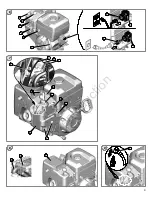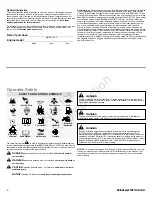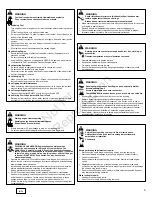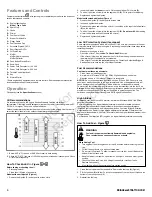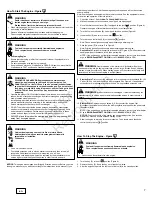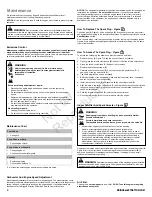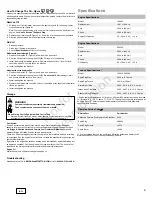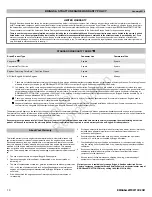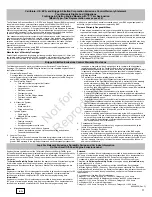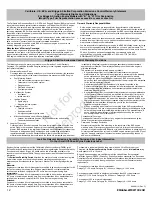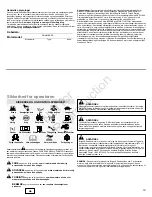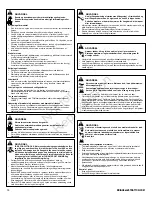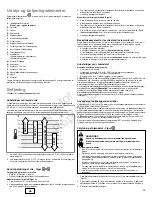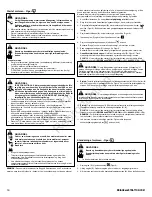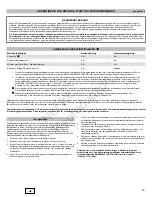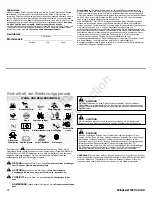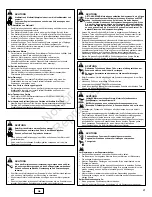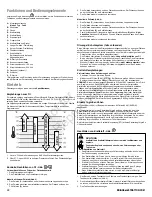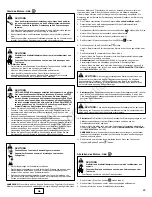
8
BRIGGSandSTRATTON.COM
Maintenance
We recommend that you see any Briggs & Stratton Authorized Dealer for all
maintenance and service of the engine and engine parts.
NOTICE:
All the components used to build this engine must remain in place for proper
operation.
WARNING:
Rapid retraction of the starter cord (kickback) will pull your
hand and arm toward the engine faster than you can let go. Broken bones, fractures,
bruises or sprains could result. When starting engine, pull the starter cord slowly until
resistance is felt and then pull rapidly to avoid kickback.
Emissions Control
Maintenance, replacement, or repair of the emissions control devices and systems
may be performed by any off-road engine repair establishment or individual.
However, to obtain “no charge” emissions control service, the work must be performed
by a factory authorized dealer. See the Emissions Warranty.
Unintentional sparking can result in fire or electric shock.
Unintentional start-up can result in entanglement, traumatic
amputation, or laceration.
Fire hazard
WARNING
Before performing adjustments or repairs:
Disconnect the spark plug wire and keep it away from the spark plug.
Use only correct tools.
Do not tamper with governor spring, links or other parts to increase engine
speed.
Replacement parts must be of the same design and installed in the same
position as the original parts. Other parts may not perform as well, may damage
the unit, and may result in injury.
Do not strike the flywheel with a hammer or hard object because the flywheel
may later shatter during operation.
When testing for spark:
Use approved spark plug tester.
Do not check for spark with spark plug removed.
Maintenance Chart
First 5 Hours
Change oil
Every 8 Hours or Daily
Check engine oil level
Every 50 Hours or Annually
Change engine oil
Check muffler and muffler guard
Annually
Replace spark plug
Check valve clearance
**
**
Not required unless engine performance problems are noted.
Carburetor And Engine Speed Adjustment
Never make adjustments to the carburetor or engine speed. The carburetor was set at
the factory to operate efficiently under most conditions. Do not tamper with the governor
spring, linkages, or other parts to change the engine speed. If any adjustments are
required contact a Briggs & Stratton Authorized Service Center for service.
NOTICE:
The equipment manufacturer specifies the maximum speed for the engine as
installed on the equipment.
Do not exceed
this speed. If you are unsure what the
equipment maximum speed is, or what the engine speed is set to from the factory,
contact a Briggs & Stratton Authorized Service Center for assistance. For safe and
proper operation of the equipment, the engine speed should be adjusted only by a
qualified service technician.
How To Replace The Spark Plug -
Figure
5
Check the gap (
A
, Figure 5) with a wire gauge (
B
). If necessary, reset the gap. Install
and tighten the spark plug to the recommended torque. For gap setting or torque, see the
Specifications
section.
Note:
In some areas, local law requires using a resistor spark plug to suppress ignition
signals. If this engine was originally equipped with a resistor spark plug, use the same
type for replacement.
How To Access The Spark Plug -
Figure
7
To access the spark plug, the snow hood must be removed as follows:
1. Remove the key (
A
, Figure 7). Keep the key out of reach of children.
2. Tightly grasp the throttle control knob (
B
) and pull it off of the throttle control lever.
3. Grasp the choke control knob (
C
) and pull it up to remove.
4. Remove the mounting screws (
D
).
5. Carefully open the snow hood (
E
). Do not disconnect the primer hose (
F
), if
equipped, or the key switch wire (
G
).
6. The spark plug (
H
) can now be accessed.
7. Before installation of the snow hood, make sure that the primer hose, if equipped,
and the key switch wire are connected.
8. Install the the snow hood (
E
) and secure with the mounting screws (
D
).
9. Align the slots in the choke control knob (
C
) with the tabs on the choke shaft (
J
) and
then push down to install. If the choke control knob is not installed correctly, the
choke will not operate.
10. Push the throttle control knob (
B
) onto the throttle control lever.
11. Do not install the key (
A
) until you are ready to start the engine.
Inspect Muffler And Spark Arrester -
Figure
8
Running engines produce heat. Engine parts, especially muffler,
become extremely hot.
Severe thermal burns can occur on contact.
Combustible debris, such as leaves, grass, brush, etc. can catch fire.
WARNING
Allow muffler, engine cylinder and fins to cool before touching.
Remove accumulated debris from muffler area and cylinder area.
It is a violation of California Public Resource Code, Section 4442, to use or
operate the engine on any forest-covered, brush-covered, or grass-covered land
unless the exhaust system is equipped with a spark arrester, as defined in
Section 4442, maintained in effective working order. Other states or federal
jurisdictions may have similar laws. Contact the original equipment
manufacturer, retailer, or dealer to obtain a spark arrester designed for the
exhaust system installed on this engine.
Remove accumulated debris from muffler area and cylinder area. Inspect the muffler (
A
,
Figure 8) for cracks, corrosion, or other damage. Remove the spark arrester (
B
), if
equipped, and inspect for damage or carbon blockage. If damage is found, install
replacement parts before operating.
WARNING:
Replacement parts must be of the same design and installed
in the same position as the original parts. Other parts may not perform as well, may
damage the unit, and may result in injury.
Air Filter
This engine is
not equipped
with an air filter.
DO NOT use this engine for anything
other than snow removal.
Not for
Reproduction



